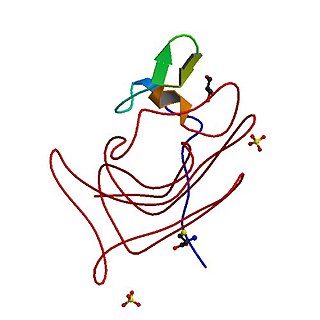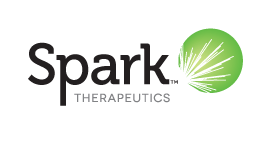
Gene therapy is a medical technology that aims to produce a therapeutic effect through the manipulation of gene expression or through altering the biological properties of living cells.

Haemophilia, or hemophilia, is a mostly inherited genetic disorder that impairs the body's ability to make blood clots, a process needed to stop bleeding. This results in people bleeding for a longer time after an injury, easy bruising, and an increased risk of bleeding inside joints or the brain. Those with a mild case of the disease may have symptoms only after an accident or during surgery. Bleeding into a joint can result in permanent damage while bleeding in the brain can result in long term headaches, seizures, or a decreased level of consciousness.

Haemophilia B, also spelled hemophilia B, is a blood clotting disorder causing easy bruising and bleeding due to an inherited mutation of the gene for factor IX, and resulting in a deficiency of factor IX. It is less common than factor VIII deficiency.

Coagulation factor VII is one of the proteins that causes blood to clot in the coagulation cascade, and in humans is coded for by the gene F7. It is an enzyme of the serine protease class. Once bound to tissue factor released from damaged tissues, it is converted to factor VIIa, which in turn activates factor IX and factor X.

Adeno-associated viruses (AAV) are small viruses that infect humans and some other primate species. They belong to the genus Dependoparvovirus, which in turn belongs to the family Parvoviridae. They are small replication-defective, nonenveloped viruses and have linear single-stranded DNA (ssDNA) genome of approximately 4.8 kilobases (kb).
Retinal gene therapy holds a promise in treating different forms of non-inherited and inherited blindness.

Alipogene tiparvovec, sold under the brand name Glybera, is a gene therapy treatment designed to reverse lipoprotein lipase deficiency (LPLD), a rare recessive disorder, due to mutations in LPL, which can cause severe pancreatitis. It was recommended for approval by the European Medicines Agency in July 2012 and approved by the European Commission in November of the same year. It was the first marketing authorisation for a gene therapy treatment in either Europe or the United States.
Self-complementary adeno-associated virus (scAAV) is a viral vector engineered from the naturally occurring adeno-associated virus (AAV) to be used as a tool for gene therapy. Use of recombinant AAV (rAAV) has been successful in clinical trials addressing a variety of diseases. This lab-made progeny of rAAV is termed "self-complementary" because the coding region has been designed to form an intra-molecular double-stranded DNA template. A rate-limiting step for the standard AAV genome involves the second-strand synthesis since the typical AAV genome is a single-stranded DNA template. However, this is not the case for scAAV genomes. Upon infection, rather than waiting for cell mediated synthesis of the second strand, the two complementary halves of scAAV will associate to form one double stranded DNA (dsDNA) unit that is ready for immediate replication and transcription. The caveat of this construct is that instead of the full coding capacity found in rAAV (4.7–6kb) scAAV can only hold about half of that amount (≈2.4kb).
James M. Wilson is a biomedical researcher with expertise in gene therapy. Wilson graduated from Albion College and the University of Michigan . He completed residency training in Internal Medicine at the Massachusetts General Hospital followed by a postdoctoral fellowship at the Whitehead Institute.
Saswati Chatterjee is a virologist working as a professor at the Los Angeles City of Hope National Medical Center in the research department. Some of the viral areas she researches are: stem cells, gene therapy, genome editing, and parvovirus. Her main and current area of research is using Adeno-Associated Virus Vectors (AAV-Vectors). Additionally, she has had a role in many publications.

Spark Therapeutics, Inc. is a developer of gene therapy treatments, which treat debilitating genetic diseases. It is a subsidiary of Hoffmann-La Roche.
Richard Jude Samulski is an American scientist, inventor, and academic recognized for his pioneering work in gene therapy and adeno-associated virus vectors (AAV) in the fields of molecular virology and pharmacology.
Jean Bennett is the F. M. Kirby Professor of Ophthalmology in the Perelman School of Medicine at the University of Pennsylvania. Her research focuses on gene therapy for retinal diseases. Her laboratory developed the first FDA approved gene therapy for use in humans, which treats a rare form of blindness. She was elected a member of the National Academy of Sciences in 2022.
Mavis Agbandje-McKenna was a Nigerian-born British medical biophysicist, structural virologist, and a professor of structural biology, as well as the director of the Center for Structural Biology at the University of Florida in Gainesville, Florida. Agbandje-McKenna studied parvovirus structures using X-ray crystallography and cryogenic electron microscopy and did much of the initial work to elucidate the basic structure and function of adeno-associated viruses (AAVs). Her viral characterization and elucidation of antibody binding sites on AAV capsids has led to the development of viral capsid development and gene therapy approaches that evade immune detection and can be used to treat human diseases such as muscular dystrophies. Agbandje-McKenna was recognized with the 2020 American Society of Gene and Cell Therapy Outstanding Achievement Award for her contributions to the field. She died in 2021 from amyotrophic lateral sclerosis.

Ultragenyx is an American biopharmaceutical company involved in the research and development of novel products for treatment of rare and ultra-rare genetic diseases for which there are typically no approved treatments and high unmet medical need. The company works with multiple drug modalities including biologics, small molecule, gene therapies, and ASO and mRNAs in the disease categories of bone, endocrine, metabolic, muscle and CNS diseases.
Valoctocogene roxaparvovec, sold under the brand name Roctavian, is a gene therapy used for the treatment of hemophilia A. It was developed by BioMarin Pharmaceutical. Valoctocogene roxaparvovec is made of a virus (AAV5) that has been modified to contain the gene for factor VIII, which is lacking in people with hemophilia A. It is an adeno-associated virus vector-based gene therapy. It is given by intravenous infusion.
Etranacogene dezaparvovec, sold under the brand name Hemgenix is a gene therapy used for the treatment of hemophilia B. Etranacogene dezaparvovec is an adeno-associated virus vector-based gene therapy which consists of a viral vector carrying a gene for clotting Factor IX. The gene is expressed in the liver to produce Factor IX protein, to increase blood levels of Factor IX and thereby limit bleeding episodes. Hemophilia B is a genetic bleeding disorder resulting from missing or insufficient levels of blood clotting Factor IX, a protein needed to produce blood clots to stop bleeding.
ASC618 is an experimental gene therapy for Hemophilia A. It was developed by Applied StemCell Therapeutics and is delivered via a hybrid of adeno-associated virus types 2 and 8. The gene therapy is hoped to be more effective than earlier gene therapies for hemophilia A.
Fidanacogene elaparvovec, also known as SPK-9001 is an experimental gene therapy delivered via adeno-associated virus developed for Hemophilia B; it partially restores factor IX production in preliminary studies.
Dirloctogene samoparvovec, also known as SPK-8011, is an experimental gene therapy developed for hemophilia A by Roche and Spark Therapeutics.







